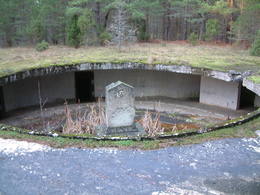Talmuto Allvee prisiminimai apie Ninase pakrantės gynybos baterijos statybą
Pirmieji statybininkai Nine pasirodė dar 1939 metų rudenį.
Pirmieji statybininkai į Ninasę atvyko 1939 m. rudenį.
Didelis baltas laivas išmetė inkarą jūroje. Jie nuleido gelbėjimosi valtį, kurioje buvo apie 20 kareivių ir karininkas. Su savimi jie nešėsi žalias dėžes. Spėju, kad juose buvo visokių techninių gudrybių. Mano tėvas nuėjo padėti kareiviams gręžti, kad paimtų šerdies mėginius. Jie turėjo gręžti rankomis. Jie pastatė statramstį su gręžimo įrenginiu viduryje ir pradėjo tempti trosus pirmyn ir atgal. Jie taip pat panaudojo sprogmenis, kad išgautų kalkakmenio žemę. Dauguma statybininkų atvyko 1941 m. pavasarį. Jie daugiausia naudojo GAZ-AA savivarčius. Sunkvežimiai buvo prikrauti smėlio ir skaldos. Buvo įrengtas akmenų smulkintuvas. Jį valdė vietiniai gyventojai, o jauni berniukai ištiesdavo ranką. Statybos darbai truko visą 1941 m. vasarą. Iškastas gruntas buvo nugabentas į uostą ir išmestas į jūrą, suformuojant naują prieplauką. Uostas buvo daugmaž toje pačioje vietoje, kur dabar yra Saremos uostas. Šalia uosto veikė kalvė ir suvirinimo cechas. Pabūklai buvo atgabenti į bateriją didelėmis rogėmis, kurias traukė du „Joes“. Be kareivių, aikštelėje dirbo ir statybininkai, kurių dauguma – elektrikai. Jiems nebuvo uždrausta laisvalaikiu gerti, o tai sukėlė daug muštynių... Tagaranoje, prie dabartinio pasienio posto, buvo pastatytas padėties ieškiklis. Kai įrenginiai buvo baigti, buvo trys dienos šaudymo pratybos. Mano tėvas man pasakė, kad jų 100 kg sviediniai matėsi skrendant ore. Darbo kolonijai priklausantys vyrai išėjo; liko apie 100 jūreivių. Karo frontas pasiekė Ninase. Į Kugalepos mokyklą atvyko vokiečių išankstinė grupė. Rusai, vairuodami vilkiką ZIS-5, pradėjo puolimą, tačiau švęsti pradėjo per anksti. Vokiečiai, aprūpinti padegamomis kulkomis, atidengė ugnį ir padegė sunkvežimį. Visi rusai mirė. Rusijos objektus bombardavo ir vokiečių lėktuvai. Prieš atsitraukdami jūreiviai susprogdino visą artileriją. Vienas iš ginklo vamzdžių išlindo iš to visiškai nepažeistas. Vietiniai vaikai besisukantį ginklo vamzdį naudojo kaip karuselę.
Talmutas Allvee, gim. 1932, Mustjalos parapija, Tagaranna kaimas (išleista Veldre, Tõnu. Nino baterija iššovė tuščia. Saarte Hääl 2014-05-10, nr. 89), Nr. 317
Susijusios vietos
317th 180-mm Coastal Defence Battery in Ninase
This coastal defence battery is situated in Ninase near the Port of Saaremaa on Tagaranna Peninsula. Following the outbreak of World War II, the Soviet Union began fortifying the Western Estonian Archipelago and a coastal defence battery comprising four 180-mm guns was built on farmland in the village of Ninase to deter the enemy. Construction work on the battery began in July 1940. Its artillery stood 200-300 metres apart, with a generator established nearby to supply the complex with electricity. The battery was not used in combat. On 20 September 1941, German troops surrounded the battery. The battery crew managed to blow up two of the guns and break through the German line.
Ninase Coastal Defence Battery is one of the best preserved historical buildings from World War II on Saaremaa and has turned into a popular tourist attraction. It has become more attractive in recent years thanks to the Mustjala Music Festival, which is held nearby.





